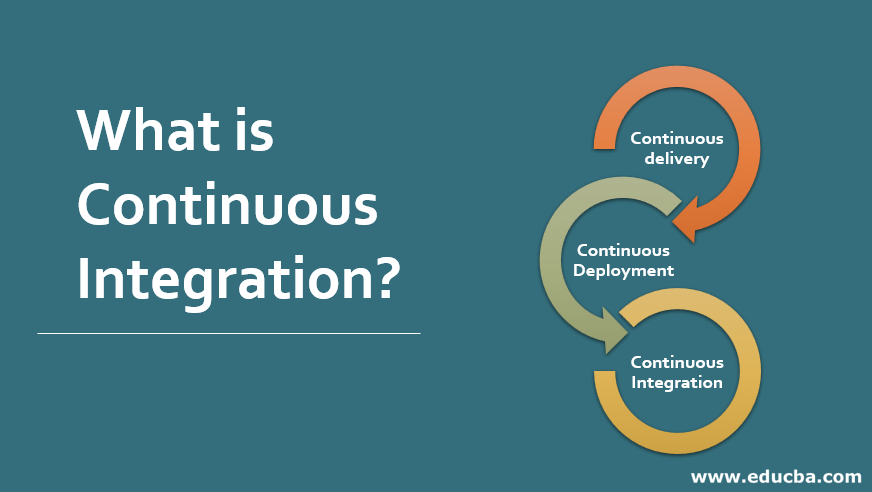Updated March 18, 2023
Introduction to Continuous Integration
Continuous integration is a development method for DevOps applications where developers merge code changes periodically to a central repository where automated compilation and tests are performed. Consistent integration usually involves both an engineering component and a cultural component in software releases’ building or installation phase. The main goals of on-going integration are quicker bugs, better software quality, and less time to test and upgrade apps. The core of the CI process is a source code version control system. Additional controls, such as automated code validation, syntax style review tools, and more, are included in the version control framework.
What does Continue Integration Does?
In order to keep your application deployed and even push your main codebase automated when further changes are introduced, continuous delivery and continuous deployment have also been developed as best practices. This will help us to allow our item to maintain the standard quality that can be automatically checked.
CI helps to increase engineering teams ‘ headcount and delivery performance. Presenting CI to the above scenario enables software developers to work in parallel independently on functions. You can do it independently and rapidly when you are ready to combine these features into the end product. In modern and high-performance engineering organizations, CI is a valuable and well-established practice.
In this, we have seen some words like Continuous Delivery, Continuous Deployment, and Continuous Integration.
- Continuous Delivery
- Continuous Deployment
- Continuous Integration
Let’s have a look at that one by one:
1. Continuous Delivery
Continue Integration ensures that you can always keep your code base deployable. In addition to ensuring automated testing of your request, all appropriate configuration is required to put it in production. Most teams push the changes to immediately ensure a fast design loop through automated tests in a test or production environment.
2. Continuous Deployment
It is closely related to continuous integration. This ensures that the software is always deployable or even released in the development and production area if all automated checks have been conducted in the latest version.
3. Continuous Integration
It is a practice to integrate changes from the different team developers as early as possible several times a day in the best cases. It means that the code for each developer is not too disturbed. Once the system is combined with automated testing, the software can be consistent through continuous integration.
How to Maintain Continuing Integration?
In application development and deployment, CI focuses on speed. Traditionally, safety doesn’t. The challenge is to secure CI without compromising software delivery. DevSecOps are going in here. DevSecOps build upon the idea that “all are responsible for protection” to ensure that safety options are safely delivered at speed without compromising security. DevSecOps comes in that way. DevSECOps draw on the premise that “everybody is responsible for safety” in order to distribute security decisions safely and quickly and without compromising the necessary safety.
Advantages of Continuous Integration
Given below are the advantages mentioned:
- In the course of incorporating other programmers, these divisions tend to differ more and more from the mainline.
- Another significant advantage over conventional design workflows is this focus on automated integration. In non-CI environments, programmers frequently work with branches of this trunk in apps over a long period of time.
- Integrating the branch of the function can be a laborious process to make all changes compatible. Unfortunately, the development industry is fearful enough that the term “integration heaven” is coined.
- CI workflows help you with simple and daily integration n to avoid the problem. In addition to saving developers time, continuous integration avoids manually integrating changes and enhances software reliability.
How can Continuous Integration be Used?
- Continuous Integration is generally used in conjunction with an agile workflow to develop software. A company compiles a list of tasks that include a roadmap for a service. Those activities are then allocated for distribution to members of the software engineering team.
- For CI, developing software tasks can be developed separately and in parallel between the developers assigned. After completing one of these projects, a programmer must introduce the new job to the CI framework incorporated with the remaining design.
- The continuous integration deployment tool. The second condition for Continuous Integration is a build tool: such a tool is capable of handling the application sources and automated development of the desired code. The construction and building tools of a computer depend on the stack selected for the technology.
As an example, here is a list of steps for a Java app:
- Test Code will compile to bytecode.
- Execute integration tests if there are any
- Store the JAR in a repository manager if needed.
- In the Control Version System tag, the code, if necessary
Conclusion – Continuous Integration
The transition from traditional manual steps into CI processes requires a profound change in how software teams function together for many traditional software organizations. Nevertheless, the advantages of continuous integration processes are evident for software companies if they are viewed together. This is now a new standard in the field of engineering, and the rise in the adoption of CI practices will only intensify.
Recommended Articles
This is a guide to What is Continuous Integration? Here we discuss introduction, how to maintain continuous integration, advantages of continuous integration. You can also go through our other suggested articles to learn more –



